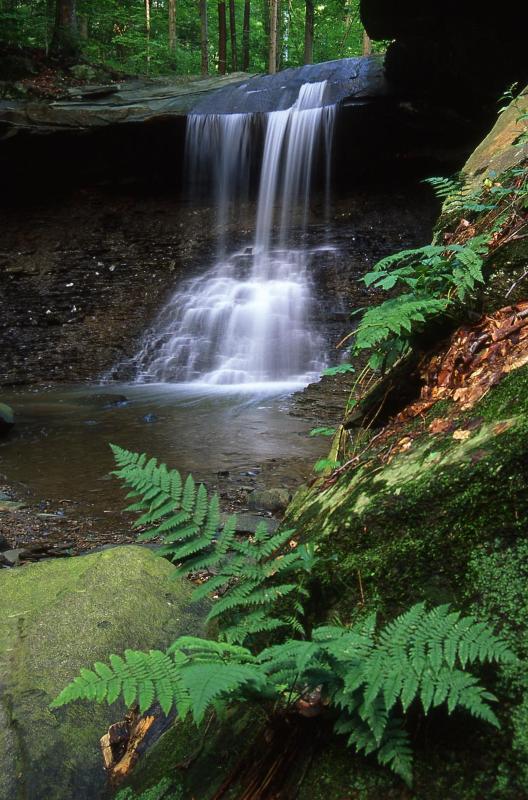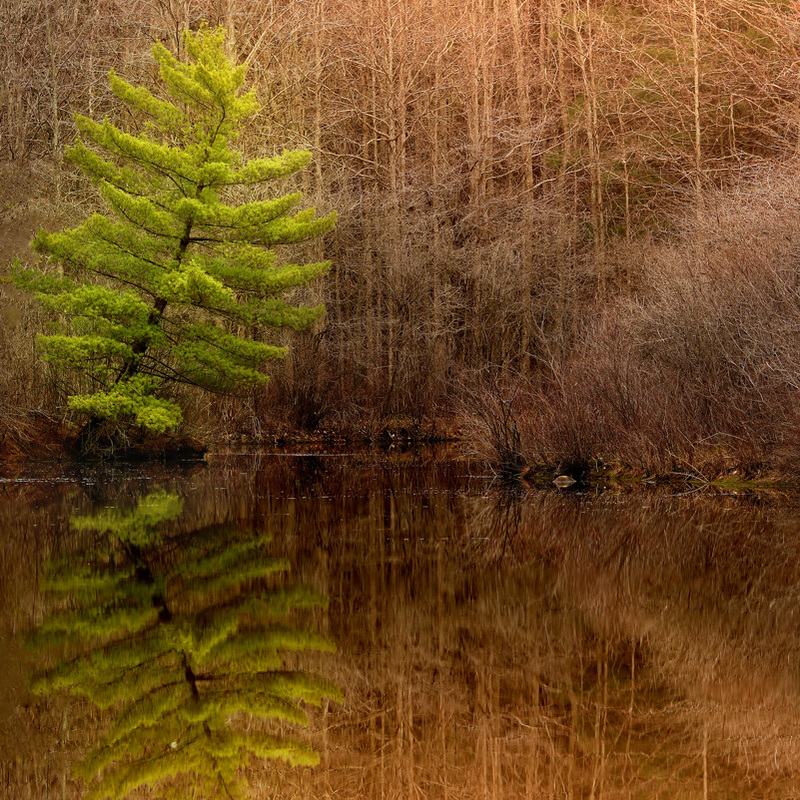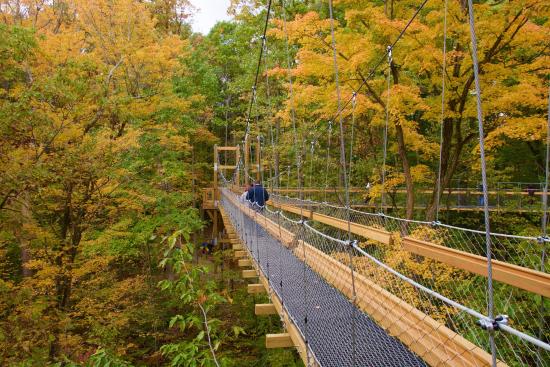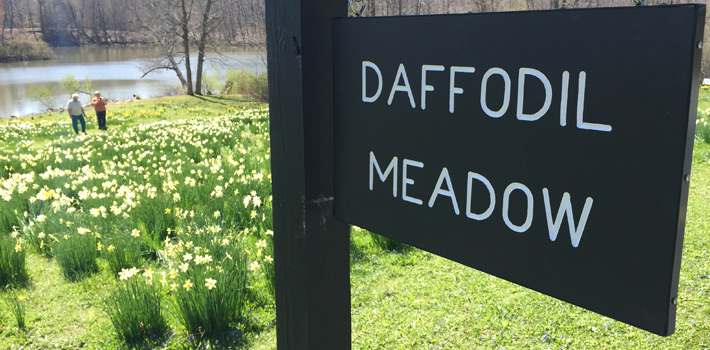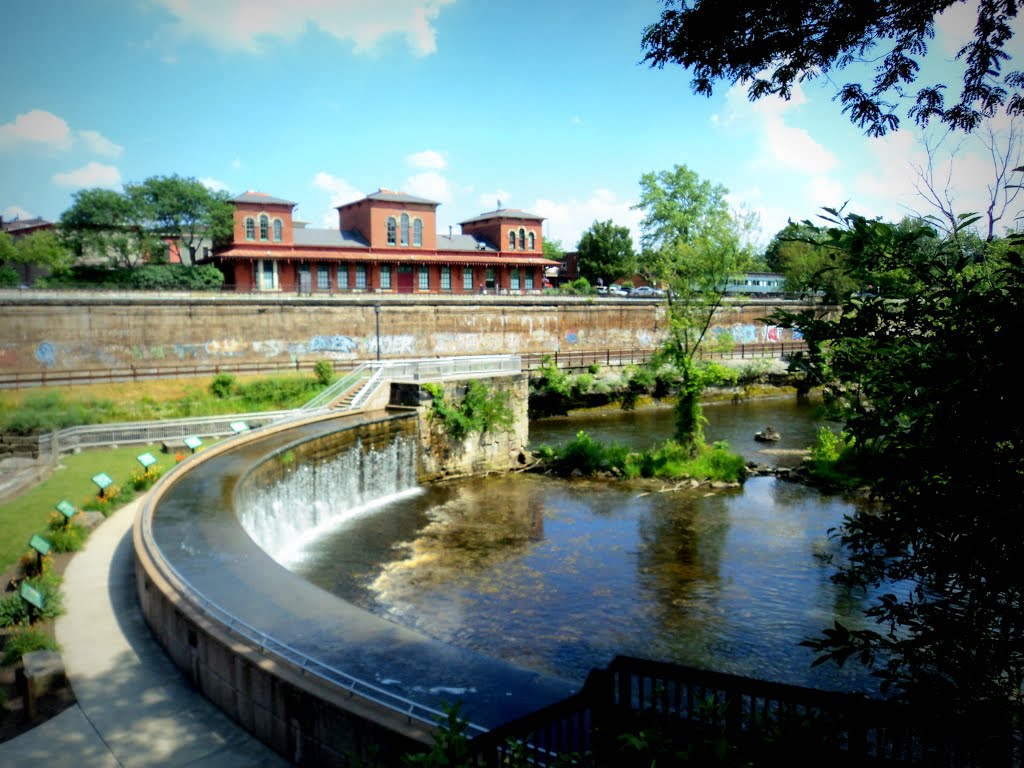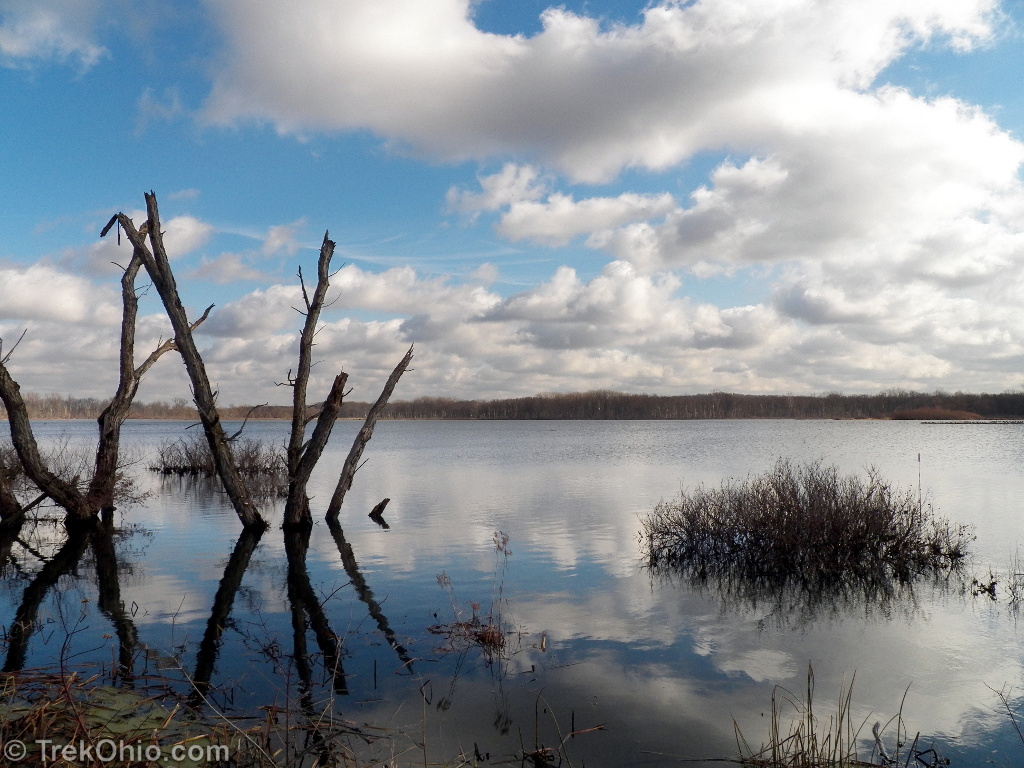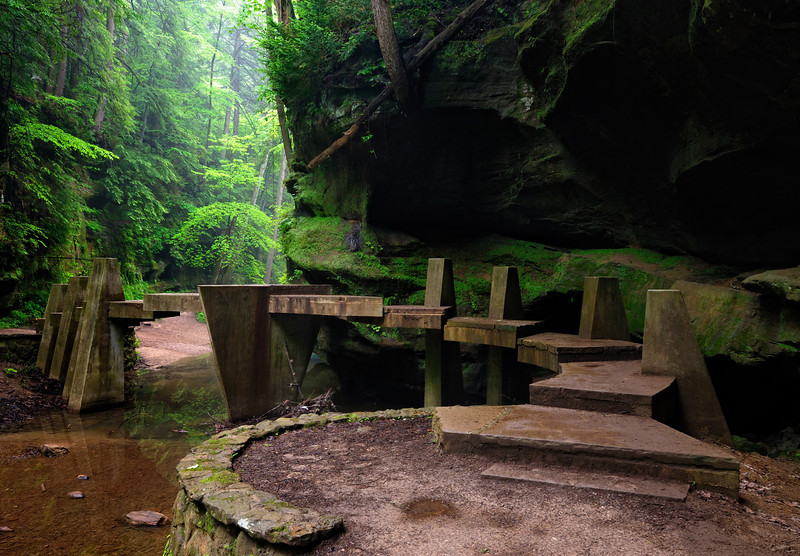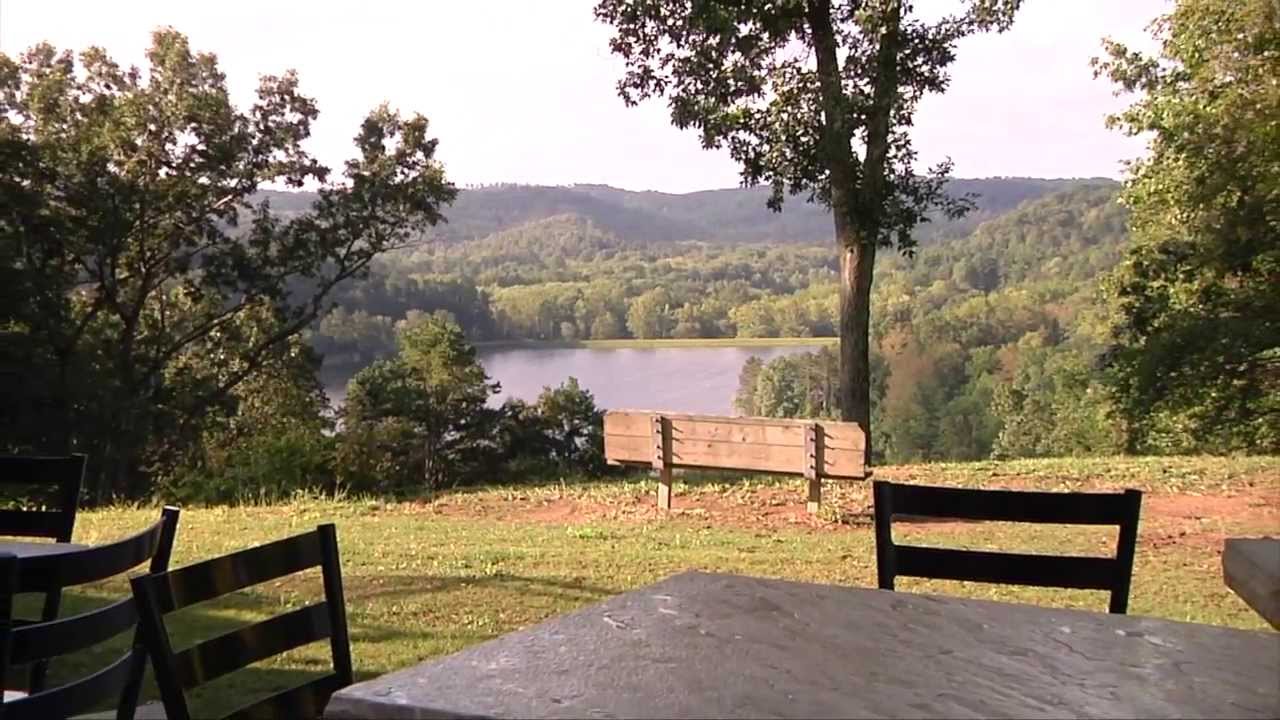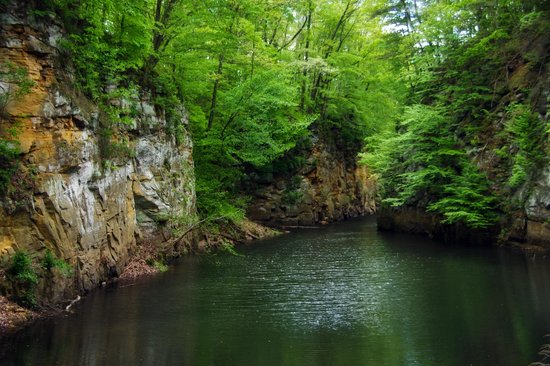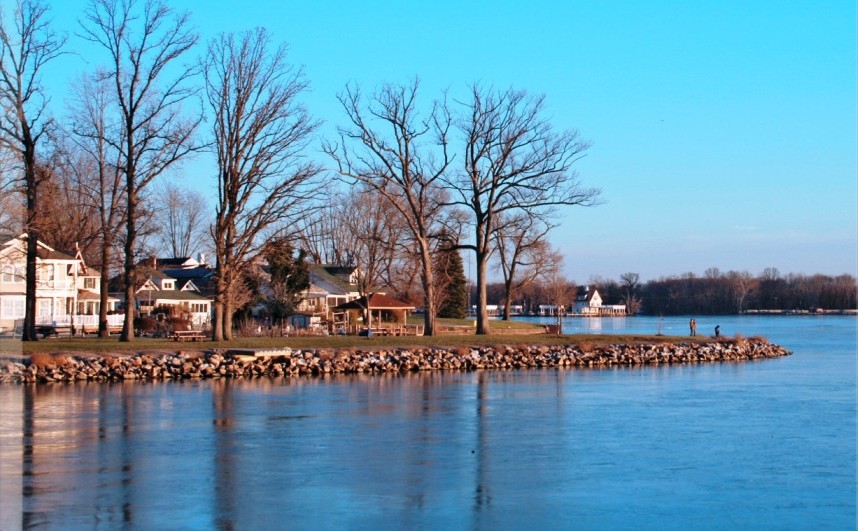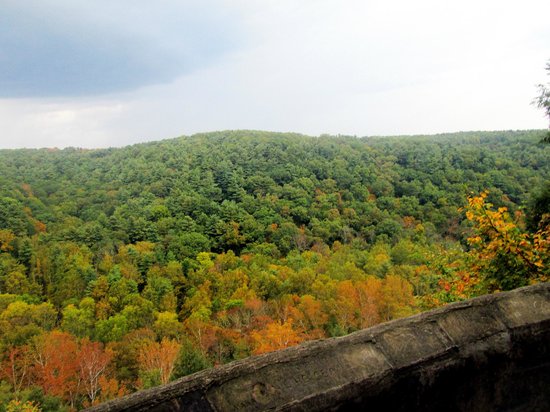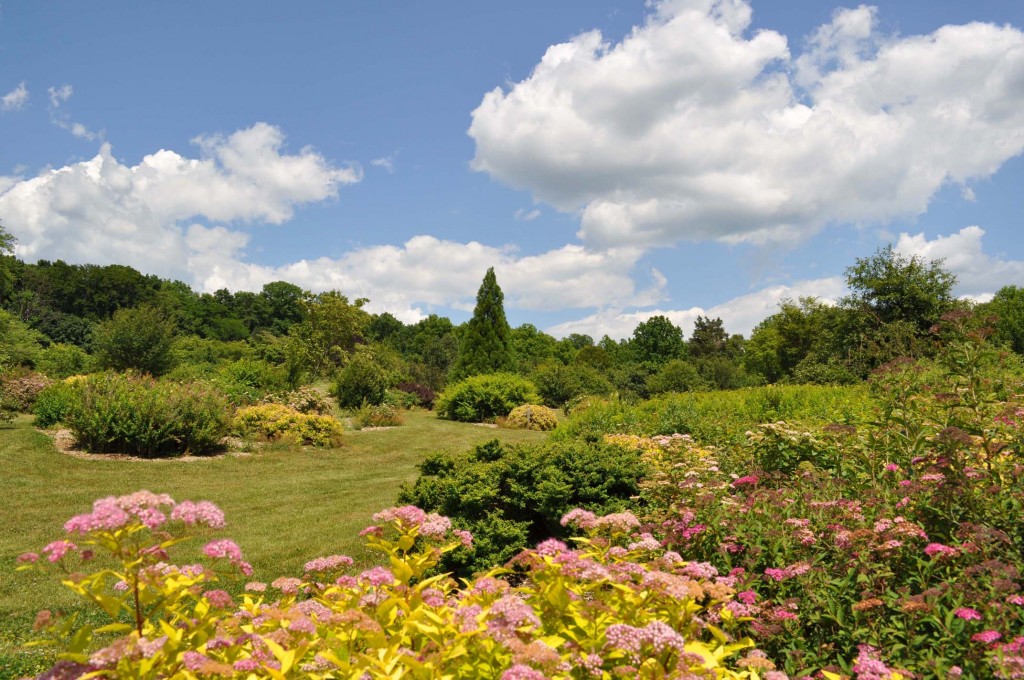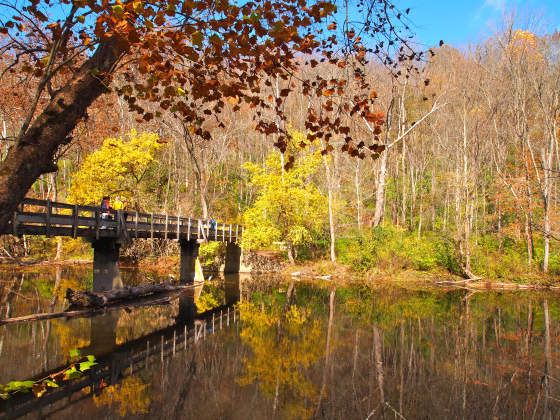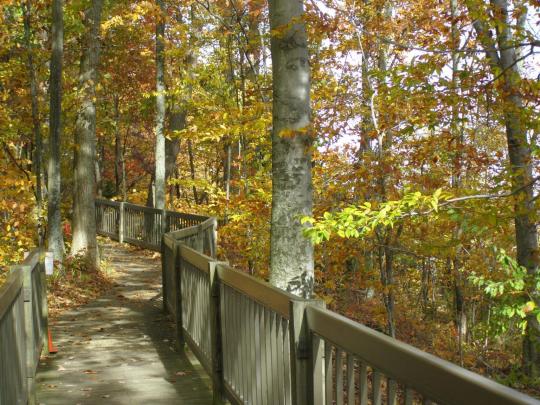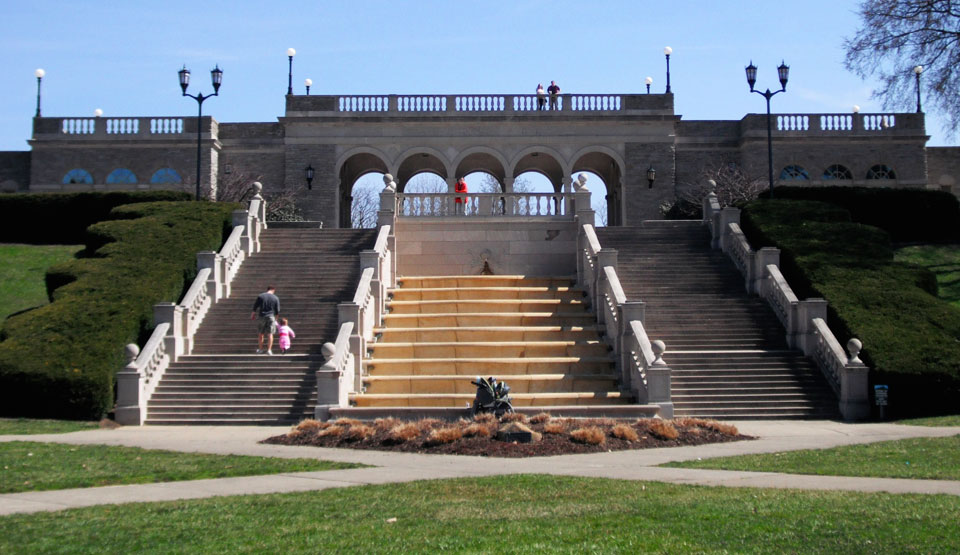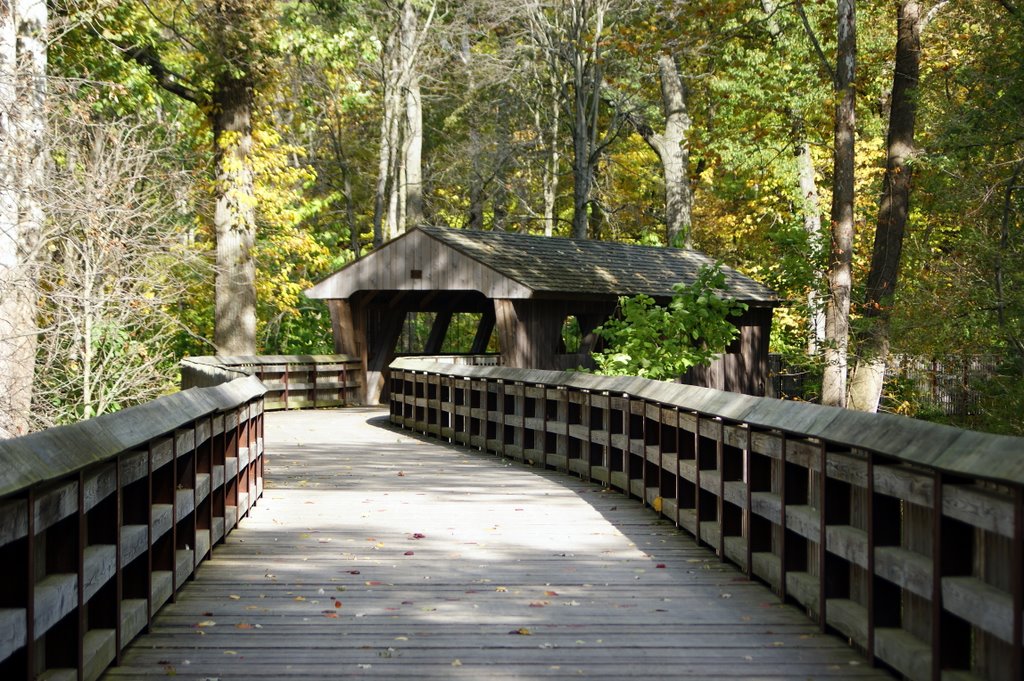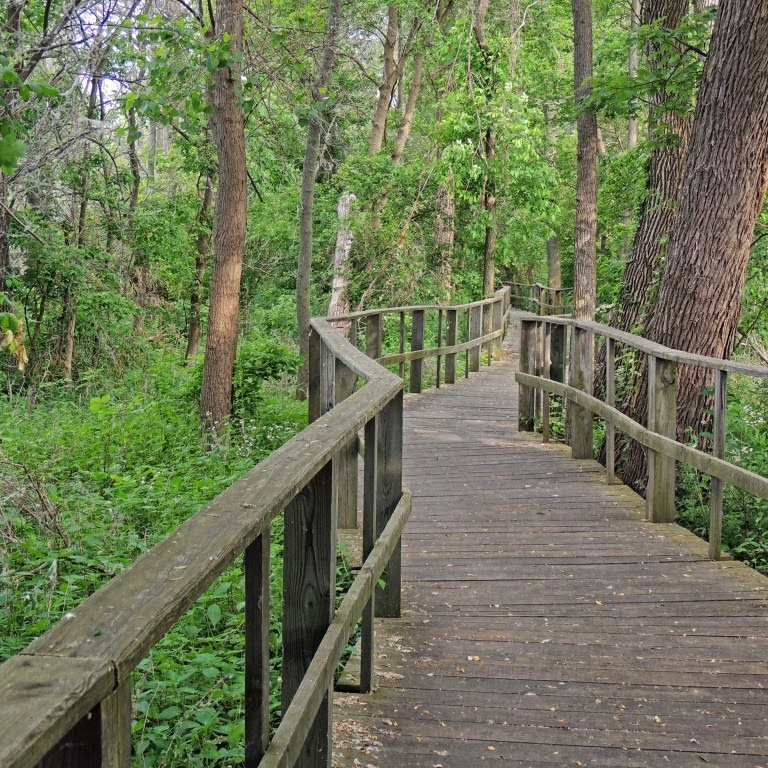Historic Tax Credit Coffees in Southeast & Central Ohio
Monday, November 18th, 2019
Have you been wondering about historic tax credit programs here in Ohio? Wondering about the application and review process? Here is an easy introduction to the 20% federal historic tax credit and 25% Ohio historic preservation tax credit which you can use to rehabilitate your historic building. Come chat at a quick informal get together to learn about how the historic tax credit programs work and meet the people who manage them.
Locations of Coffees:
9:00 – 10:00 AM Athens: Athens Community Center – 701 East State Street
12:00 – 1:00 PM Somerset: Village Hall – 100 Public Square
2:30 – 3:30 PM Lancaster: Chamber of Commerce – 109 North Broad Street
5:00 – 6:00 PM Columbus: Fortin Ironworks – 944 West Fifth Avenue
Go Outside and Play: Ohio’s 23 Best Parks
The Best State Parks and Metro Parks Across Ohio
Ohio has natural beauty in spades! We ought to know, we spend much of our year traveling around the state, and the team at Heritage Ohio has some pretty strong opinions on the best parks in Ohio. Here’s our favorite state, city and metro parks, organized by region:
Northeast Ohio Parks
Cuyahoga Valley National Park
Cuyahoga Valley National Park is Ohio’s only national park, but you couldn’t ask for a better example of Ohio’s natural splendor. Just a short drive south of downtown Cleveland, Cuyahoga Valley has plenty to offer any visitor. A few highlights of the park are the 65-foot high Brandywine Falls, the Cuyahoga Valley Scenic Railroad, and the historic village of Peninsula.
Ohio’s National Park covers 33,000 acres of parkland, leaving you and your family many weekends of exploration.
Where to Stay at Cuyahoga Valley National Park
We say get closer to nature and camp or rent an RV when exploring Cuyahoga Valley National Park! Find all the details to plan your trip here.
Liberty Park – Twinsburg
Just outside of Twinsburg is one of the hidden gems of Northeast Ohio. Liberty Park has a diverse offering of natural spaces for a suburban park. Visitors will delight in the natural beauty of the Tinkers Creek Nature Preserve and the towering Twinsburg Ledges area, both located in the park. You can explore both and more on the numerous trails within the park.
Holden Arboretum
Holden Arboretum is just a short drive from historic downtown Chardon in Geauga County. The arboretum will be a unique experience for many visitors, including Ohioans. Some of the many offerings of the Holden Arboretum include a butterfly garden, several rhododendron gardens, a hedge collection, and the famous Canopy Walk.
Mill Creek Park
It may be hard to believe, but Mill Creek Park in Youngstown rivals other large metropolitan parks like Central Park in terms of absolute beauty and depth. The sprawling park covers 4,400 acres and has diverse areas and topography. Highlights of the park for new visitors include Lanterman’s Mill, several historic bridges, the Wall Garden, and many archaeological sites from Youngstown’s steel-making history.
Franklin Mills Riveredge Park
Located in downtown Kent, Franklin Mills Riveredge Park is small compared with other parks on this list, but will surprise you with its design and features. The main focus of the park in the Cuyahoga River with an arched stone dam. You can explore the river along a boardwalk that follows the river. There are plenty of observation areas, as well as benches and tables to enjoy your day in downtown Kent.
Bonus: Killbuck Marsh
Located between Millersburg and Wooster, Killbuck Marsh is a hidden gem just south of Route 30. The area has an extensive natural history, and several Ice Age animals such as mastodon have been unearthed. Some of these animals can be seen at the Killbuck Valley Museum, just down the road.
Southeast Ohio Parks
Hocking Hills State Park
Hocking Hills is quite possibly the most famous of all the Ohio State Parks. Within minutes of arriving, you will certainly see why. The park is divided into five sections, but really they are parks within parks and all worth a visit. Absolute must-see features include the falls at Old Man’s Cave, the Cantwell Cliffs, and the nearby Conkle’s Hollow State Nature Preserve.
Beyond the parks, there are rustic cabins to stay in the area and lots of unique small towns to explore.
Where to Stay in Hocking Hills
Hocking Hills has a wealth of lodging options, including treehouses, luxury yurts, cabins, and even a cute vintage train car!
Lake Hope State Park
Just south of Hocking Hills State Park is Lake Hope. The park is encapsulated by Zaleski State Forest, making for some beautiful scenery. The beach is a great place to relax and go for a swim. The area has numerous hiking trails and connectors, including a trek up to the famous Moonville Tunnel. You can also visit the restored Hope Furnace, a blast furnace that sits near one end of the lake.
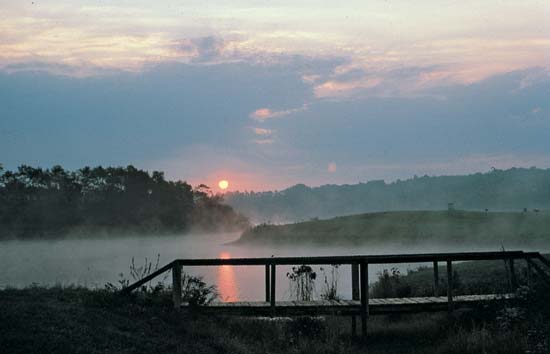
Salt Fork State Park
Just a few miles from historic Cambridge, is Salt Fork State Park, Ohio’s largest state park. The Park surrounds much of Salt Fork Lake and offers a variety of activities, such as hiking, boating, horseback riding, and golf.
Where to stay at Salt Fork State Park
The Salt Fork Lodge is a great place to stay with the family, as well as host a conference.
Central Ohio Parks
Blackhand Gorge State Nature Preserve
Named for a famed, and lost, Native American petroglyph that was found in the gorge, Blackhand Gorge is one of the most beautiful areas in Central Ohio. The preserve has many hiking trails to explore, as well as remnants of its past, including a section of the Ohio & Erie Canal locks and an interurban tunnel. Visitors can also explore the area via canoe or kayak on the Licking River.
Buckeye Lake State Park
Renowned in Central Ohio for boating, Buckeye Lake State Park is a water lover’s paradise. The lake is surrounded by quaint communities, and has plenty of activities for non-boaters as well. You can even visit Cranberry Bog, which is a natural marvel. Tours of the bog usually occur in June.
Mohican State Park
Located between the historic communities of Wooster, Millersburg, Mount Vernon, and Ashland, Mohican is a forested oasis and perfect for a weekend getaway. The park has several hiking trails, campgrounds, and even a covered bridge.
Where to Stay at Mohican State Park
For a unique place to stay during your visit, check out the treehouses at The Mohicans.
Dawes Arboretum
Just east of Columbus, you will find a true gem of a park, Dawes Arboretum. The Arboretum seems to have it all: historic Daweswood Farm, numerous trails, a nature center, formal Japanese garden, and even a driving tour. It’s a definite stop for any nature lover, and best of all, it’s free to visit!
While in the area, make sure to visit the newly revamped downtown in Newark and catch a show at the historic Midland Theatre.
Rhododendron Cove State Nature Preserve
Located just south of Lancaster, Rhododendron Cove Preserve sits on an unassuming hill, but offers a bounty of beauty once you make it to the summit. Atop the hill are dozens of Rhododendrons nestled amongst rocky outcroppings, making for great photography. After visiting Rhododendron Cove, travel down the road and visit two additional parks: Wahkeena Nature Preserve and Clear Creek Metro Park.
Bonus: Topiary Park
On the east side of downtown Columbus, The Topiary Park is a living art installation on the grounds of the former Ohio Deaf School campus. Visitors can either take docent-led tours or explore the park on their own. In addition to the numerous plant sculptures, there is also a “tree walk” visitors can take to see the many types of trees within the park. Choosy Traveler has details on some other worthwhile parks in the Columbus area, including Battelle Darby Creek, where you can see wild bison, and Shrum Mound.
Where to Stay in Columbus / Central Ohio
Columbus has a number of incredible hotels to suit every taste, from the stunning historic art deco Leveque Hotel, to the beer-tap-in-every-room Doghouse Hotel, and quaint vacation rentals in the historic German Village neighborhood.
Southwest Ohio Parks
John Bryan State Park – Clifton
Located near the historic Village of Clifton, John Bryan State Park is defined by the Little Miami River and the Clifton Gorge area it carved out. The striking features of the gorge and the forested landscape surrounding it make for some beautiful hiking scenery year-round. The next time you visit Clifton Mill, make sure to stop by John Bryan State Park.
Caesar Creek State Park
Nestled between Waynesville and Harveysburg, Caesar Creek State Park is a fossil hunter’s playground. You will need to apply for a fossil collecting permit to hunt fossils at the park, but it is well worth the effort. Some common finds include trilobites, brachiopods, and corals. In addition to fossil hunting, the park also offers camping, swimming, and boating. Other attractions in the area include historic downtown Lebanon and Caesar’s Creek Pioneer Village.
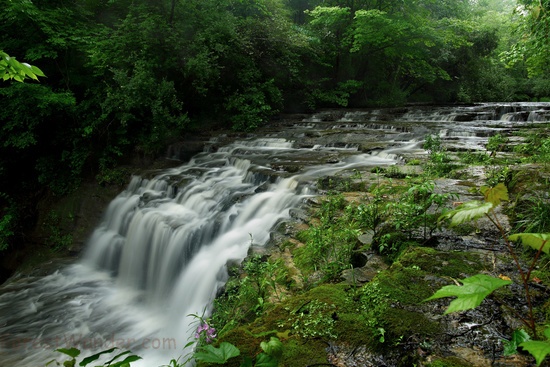
Fallsville Wildlife Area
Like the name suggests, the prominent feature of the Fallsville Wildlife Area is a large, serene waterfall. The small park packs in the beauty and is perfect for a relaxing afternoon stroll to the eye-pleasing waterfall and old mill site.
While in the area, check out the historic downtown of nearby Wilmington. There are a lot of great shops and the inside of the Clinton County Courthouse is stunning.
Ault Park
When you look at “must-see” lists of Cincinnati, you will undoubtedly come across Ault Park. A visit to the park will certainly show you why. As you arrive, you will immediately notice the large and picturesque Renaissance-style pavilion, popular with wedding parties. Beyond the pavilion, you will find several walking trails, a beautiful botanical garden, and plenty of relaxing space.
Where to Stay Near Ault Park in Cincinnati
Even if you only stop by to gawk at the truly incredible art deco lobby, Cincinnati’s Netherland Plaza Hotel is not to be missed!
Northwest Ohio Parks
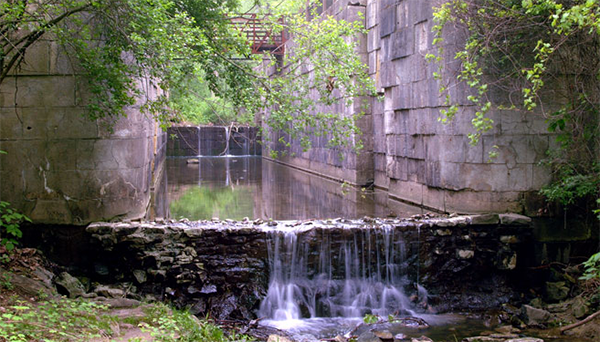
Side Cut Metropark
Side Cut Metropark is steeped in history. The park occupied land that was once part of a side cut of the Miami & Erie Canals. You can still visit 3 of the 6 locks from the canals, having been restored by WPA workers in the 1930s. Beyond the historic locks, the park offers picturesque scenery, an extensive network of trails, and plenty of wildlife.
Wildwood Metropark
Wildwood Preserve was once the home of Champion Spark Plug founder, Robert Stranahan. The park has an amazing wooded trail network and the property still has the Georgian Colonial Manor House Stranahan built. It is a must visit park in the heart of Toledo.
Magee Marsh Wildlife Area
Every spring, thousands of migratory birds visit Magee Marsh on their way to their summer nesting spots. Located on the shore of Lake Erie, the marsh is not only a destination for birders, but the extensive trail network of the wildlife area and nature center make for a great afternoon out with the family.
North Bass Island State Park
Unlike other parks on this list, getting to North Bass Island is a bit challenging to get to, but worth the hassle. Currently, the only means to get to the island are boat and airplane. Once you get to the island, you’ll be able to take in the gorgeous, untouched wilderness. Fishing is permitted on the island, as well as hiking and camping via permit.
More Ohio Love:
Shop Local: Best Ohio Gifts and Souvenirs from Local Artisans
![]()
Visual clues at the Fairfield County Infirmary Pt II
Yesterday we started reviewing a site visit to the Fairfield County Infirmary. Today we’ll take a look at a sandstone outbuilding on the property.
When I mentioned my excitement yesterday about the outbuildings, these pictured below were a big source of the excitement. Too often, unfortunately, these buildings are lost.
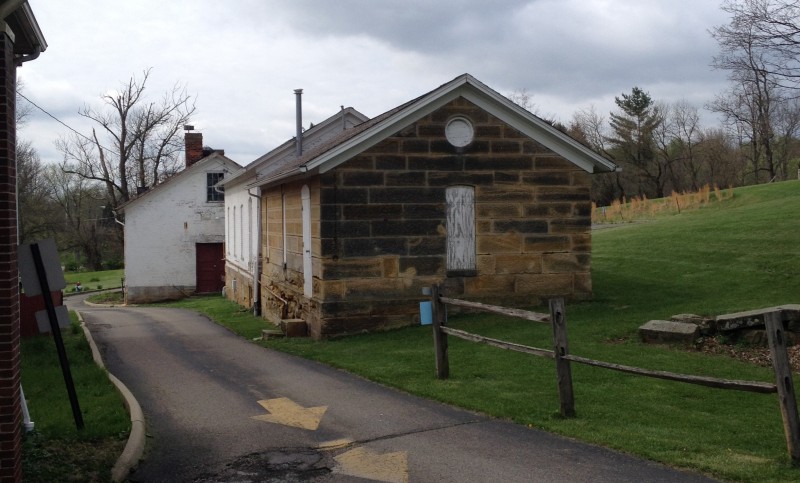
The outbuildings on a site can provide a richer detail of the day-to-day existence of the residents. Whether they were constructed with inferior materials or techniques, or decisions about ongoing maintenance focused on the main building to the detriment of the other buildings on the site, outbuildings can be too quickly and too easily lost to demolition.
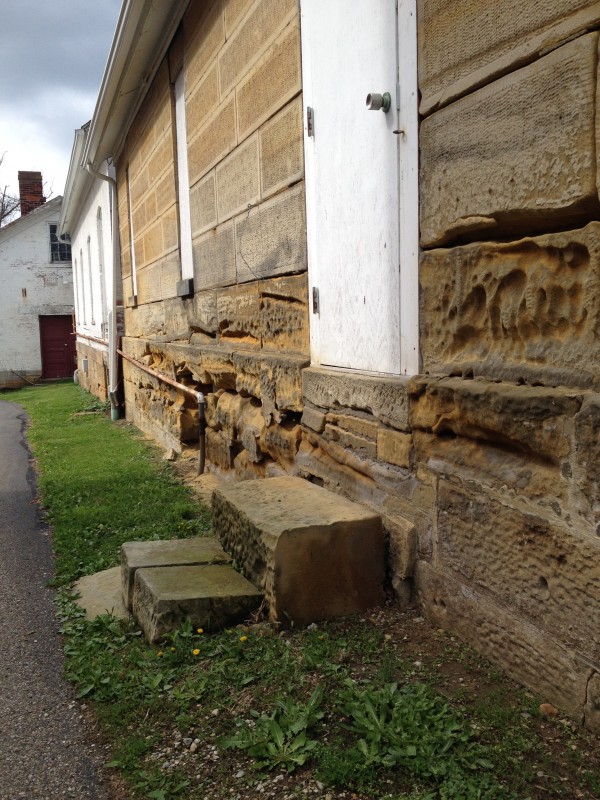
The building in the foreground was well-constructed (obviously) with sandstone block composing the walls. But even a building material as sturdy as sandstone block can fall prey to the dangers of moisture. During the summer we may have hot and humid air just outside of this building, while the air temperature inside could be significantly cooler. Just like a cup of cold water will “sweat” in the hot summer air as water vapor condenses on its surface, water vapor in the air will condense on the cooler sandstone. While sandstone is an incredibly strong stone, its strength is compromised when wet, allowing deterioration to occur. In winter, when the warmer, wetter air in the interior of the building hits the colder, drier air, we have condensation, and ice.
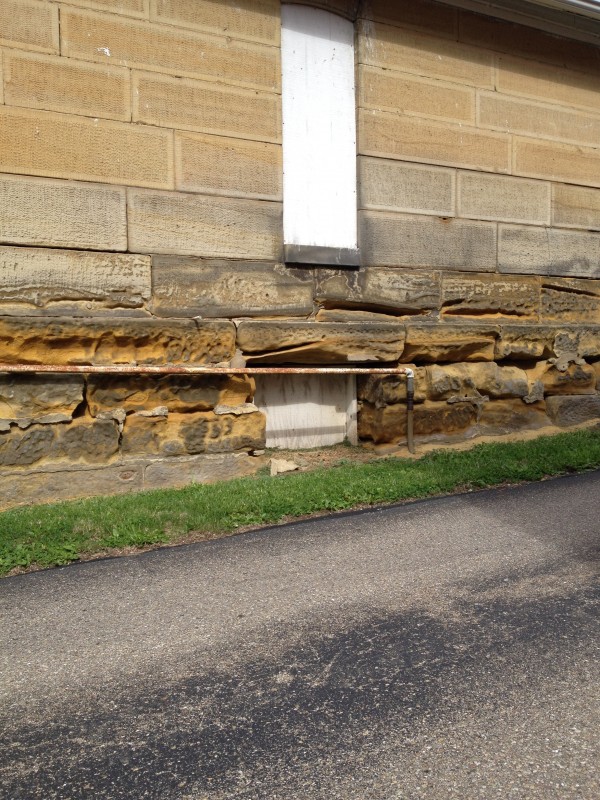
The condensation and freeze/thaw cycles on the building contribute to an almost constant deterioration cycle. The moisture will attack the inherently weaker areas in the sandstone, and given 150+ years, the sandstone will show the pockmarked appearance, as the sandstone loses its binder. Working to equalize humidity and temperature levels between the outside and inside of the building will help to slow the deterioration. Otherwise, the owner of the building will have a large repair bill in the future, having to replace or restore the sandstone.
Given the location of the road and its proximity to the sandstone outbuilding, it’s also possible that salt-laden snow has been repeatedly piled against the lower wall. Any dissolved salt that penetrates the stone and refreezes will certainly speed deterioration of the stone. It’s important to try to keep all the possibilities in mind when assessing buildings and the site.
I’ll finish today’s post with a couple site photos, since the setting of the infirmary seemed very peaceful, especially on the day we visited.
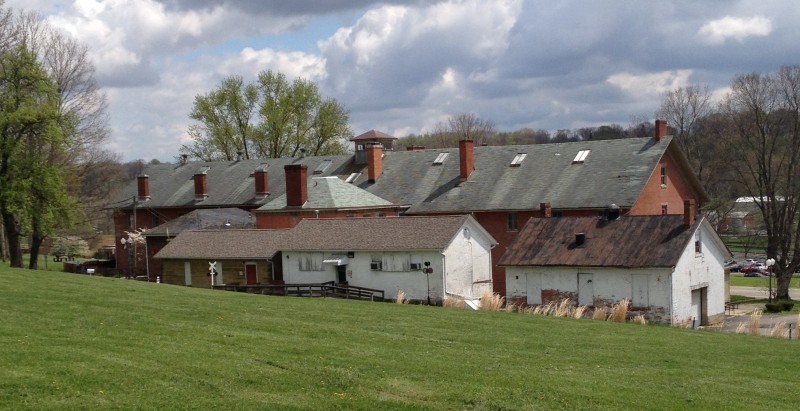
With these two images of the back elevation and front facade of the building, you can get a sense of the topography of the site. Add active springs into the mix, and site drainage becomes an even more critical issue. There are places in the main building where you can hear the rush of the underground springs as they channel the water through the property.
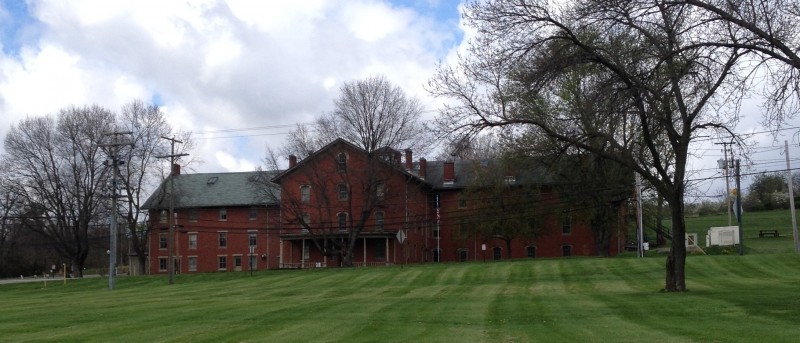
The front lawn in this image is actually on the other side of Route 37. The county owned nearly 2,000 acres, I think, at its height for the infirmary site, but most of the land has been parceled off and sold. The lawn in this picture is part of OU’s Lancaster branch site.
We’re keeping close tabs on the fate of the complex and we’ll be sure to keep you updated as we learn new information. Thanks to Jon Slater, Fairfield County Auditor, and Dennis Keller, Facilities Manager, for hosting us and giving us a peek into an important piece of Fairfield County history!
Visual clues at the Fairfield County Infirmary Pt I
Back in early May, Jeff and I visited the Fairfield County Infirmary. The main building is commonly known as the Miller Building. The campus is located on State Route 37, north and east of downtown Lancaster. The site is hilly and very picturesque, with underground springs that originally provided the water needs for the campus.
Jeff and I visited that day to tour the site with Fairfield County officials. The campus is nearly 100% vacant currently, and commissioners have sought ideas for redevelopment (thankfully, they are entertaining redevelopment options that include the preservation and continued use of some, if not all, of the buildings located on the site).
It was a thrill to tour through buildings dating to the 1820s, and to see so many of the site’s outbuildings that had survived, some in continued use even today. As we toured I paid special attention to what was happening with the buildings and the site. I kept in mind questions such as: how do the locations of buildings on the site (and the grading on the site) contribute to the protection of buildings and materials, or contribute to their deterioration; how have alterations and repairs protected buildings or sped their deterioration; and how have differences with temperature and humidity affected building materials. I’ll report on what I found over the next couple posts.
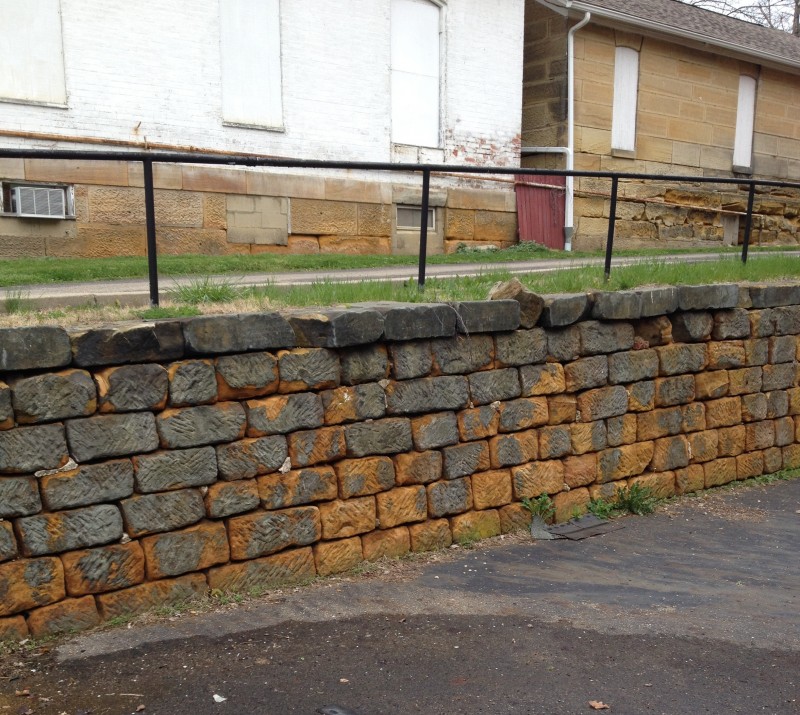
While it was initially puzzling to see this distinct two-toned appearance on the sandstone retaining wall, a closer investigation of the individual blocks points to a probable cause.
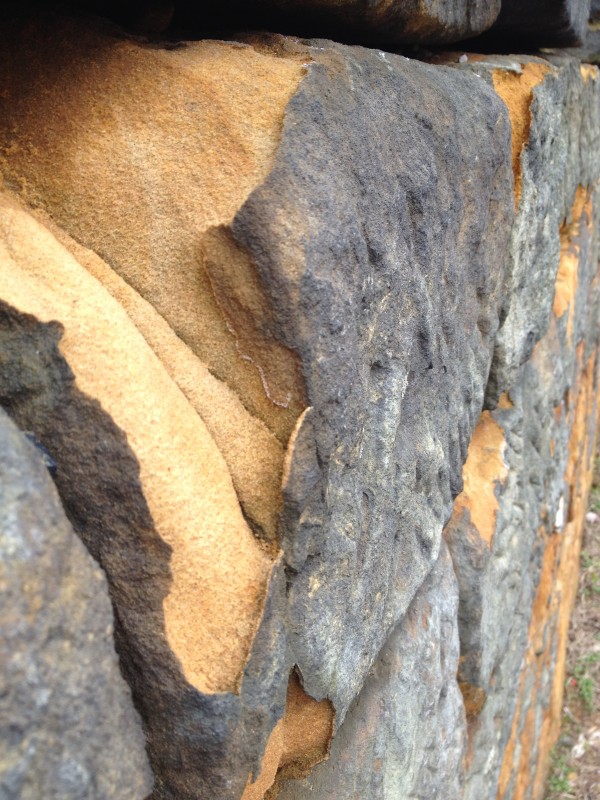
The two detail shots show what appears to be an intact stone crust, but a deteriorated interior structure. This means that water or water vapor was likely trapped within the stone. In other words, the surface of the stone became impermeable, not allowing trapped water or water vapor to pass through. Typically, if a stone or brick is coated with an impermeable sealer, the water or vapor collects against the inside face of the stone. The sustained wetness, not to mention freeze-thaw cycles, will cause the continual deterioration of the stone, as the water cannot escape, while the outside face of the stone appears relatively sound.
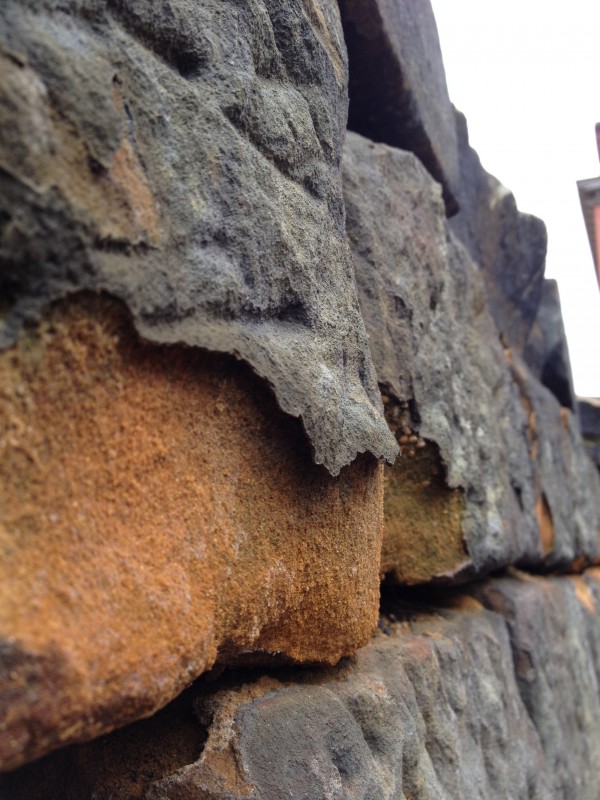
The sealed or “protected” face of the stone remains relatively deterioration-free, until the complete disintegration of the interior structure of the stone causes the crust to flake off, due to a lack of any internal support.
These images provide a perfect example of why I get nervous any time I hear someone talking about the need to “waterproof” or “seal” a masonry surface. While there are sealers that work well with masonry when there is a true need, so many times we see the sealer doing more damage than good because: 1) the masonry wall does not actually need to be sealed, and, 2) the sealer does not allow water vapor to pass through, trapping interior moisture within the masonry, speeding up deterioration.
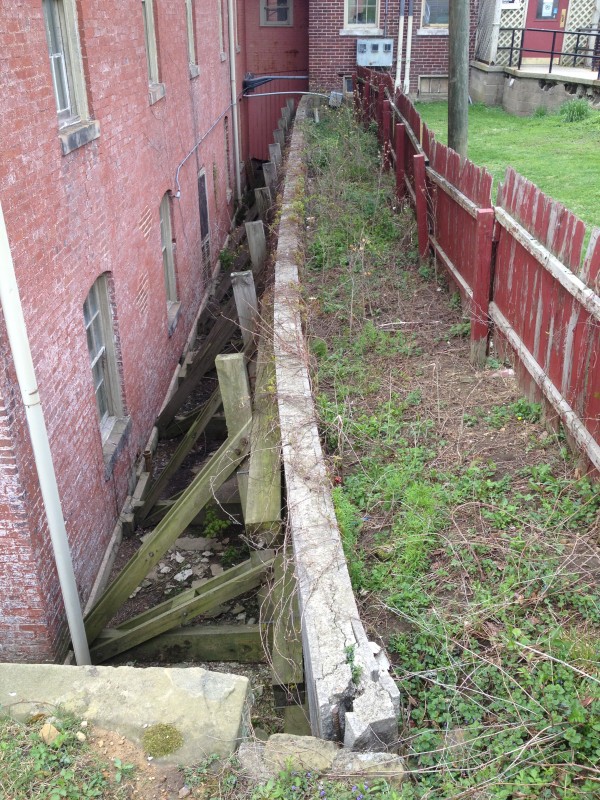
There’s no mistaking that masonry can be a very strong building component, when used the right way. When masonry is stacked, such as the brick used in the building in this image, its ability to hold up the structure and work against gravity is impressive. However, masonry is no match for forces pushing against a wall (as opposed to forces such as gravity, which pushes down through the wall, not against it). Here, a single thickness concrete block retaining wall shows a visible bow as the pressure exerted by the earthen hill exceeds the strength of the bond between the block and the mortar in the retaining wall.

What I really like about this image is the well-worn sandstone door sill. On the day this sill was placed, the plane across the top of the stone was level and straight. The wear we see in the image is the tangible evidence of the people that came before us, thousands of steps coming into or out of the building, crossing the threshold.
Also interesting to note is the lower rail of the screen door. Instead of fabricating the typical rectangular shape, someone accounted for the gap created by the wear and cut a custom fitted rail, conforming to the dip in the stone.
I’ll be back tomorrow with more visuals from our visit, and more thoughts about the different forces acting upon the buildings.


